#EARLY METALWARE
Explore tagged Tumblr posts
Text
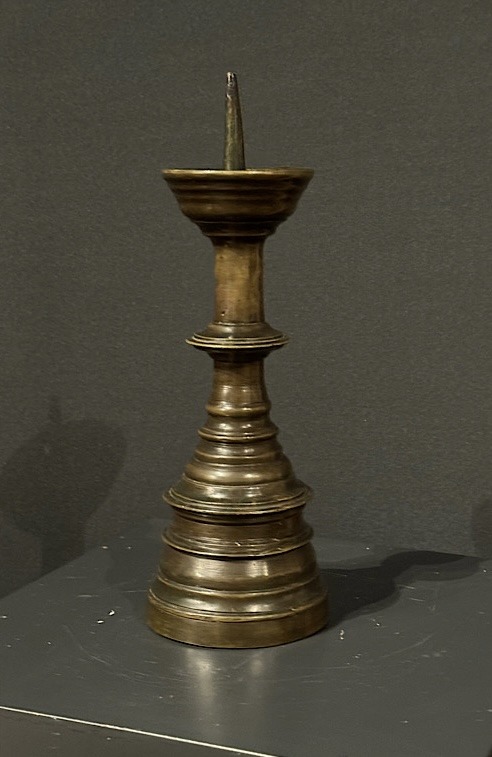
THIS EXTREMELY PLEASING PRICKET CANDLESTICK IS MADE FROM BRONZE WHICH HAS TAKEN ON A WONDERFUL COLOUR AND PATINATION, THE DIMENSIONS ARE VERY APPEALING. LOVELY EARLY PRICKET STICK.
Visit us at: https://www.periodoakantiques.co.uk/antique-early-metalware/a-fine-late-medieval-broze-pricket-stick-circa-1500-31-stockno-1726/
0 notes
Text
ordered an archaeological report on the late tang famen temple textile finds with high definition full colour photography and illustrations :3
#i have some pdfs on famen temple already but they only have info on the metalware and pottery & etc#and i really wanna have a good source for late tang extant garments#probably also gonna order the early tang murong zhi tomb report too but its like twice the price. weeps
1 note
·
View note
Text
This is my piece for the zine celebrating 10 years of dishonored: Dunwall Days and Karnaca Nights! There are leftover sales going on here: (link) that have much much more than my little character study going on. (I recommend the notebook). @10yearsofdishonoredzine
Things Beyond Forgiveness | (ao3 link)
Billie was made by knife, and now there’s nothing she sees in her body anymore but the jagged shape carved.
He was made by knife too, she thinks, watching the Outsider in their tiny, one-room apartment. A god once, held on high - now washing the dishes of all things. They had to buy metalware so when his shaking, unpracticed hands dropped them from the sink they wouldn’t shatter across the hardwood floor. Only irritate the neighbors.
“I’m sure I��ve done this before,” The Outsider tells her, lips thin with displeasure at himself. He said the same thing about sweeping up porcelain shards with a broom or writing in the blocky hand of an illiterate dockworker. She can’t prove or deny these claims, so she takes them at face value, nods, and lets him continue in his failure. Sometimes she finds herself getting irritated, having to reteach an adult man how to do up his tie, but then she remembers Sokolov and his shaky, fading memory - a parallel that would have the Outsider steaming and ranting at her.
The Outsider is neither physically old nor dependent, but something in the comparison softens her demeanor. There are people she’s taken care of before, and people she’s let take care of her. She reminds herself of this every time the Outsider goes to pick up the dishes after dinner with his quivering hands. She sits and watches this vestige of a life long past curse when his hand slips. Hum absently and splash water onto their floor.
He struggles and doesn’t have the forbearance to hide it from her, but still, sometimes she uncharitably thinks he’s doing this much better than she is. That it’s unfair. There’s a capacity to hurt in her, one she faces every day when she sees the posters bearing her name, or looks carefully at the knife in her hand and in her heart. She doesn’t think she’ll ever stop facing it.
They’re in a dark, cold alley a few blocks away from the apartment when the Outsider speaks up, voice quiet but weighted: “You’re not what you think you are.”
“How so?” Billie takes a sharp drag of the cigarette in her hand before offering it over, the Outsider considering it like he’s never seen one before. They’ve smoked together a few times before, hazy trails of smoke drifting through the afternoon light peeking in through the window in their apartment. Never like this though, in the early hours of the morning when Billie gets back from one of her odd jobs, knife and crossbow slung low on her belt. She’s been a killer for decades, even before Daud - there’s nothing that will ever change that. But she can’t help listening, can’t even pretend to ignore him like she would have in the beginning.
“You can’t change what you’ve done in the past,” The Outsider says, never having lost the uncanny ability to seem like he’s reading her mind. He pauses to take a puff of the cigarette and gives a little cough with weak lungs. Before, he would have been sent into a full-on fit. “But you can’t say you would have been here, would have survived, if not for your skills. You did what you had to.” He pauses, perhaps correctly guessing that she doesn’t want to hear it. He forges on anyhow. “Maybe you can thank yourself and move on. Find a new use for your skills.”
A bitter little laugh bursts its way out of her, unwilling. “There’s no other use for skills like mine.”
He touches her hand, not a slip of the fingers when passing a cigarette back and forth - still holding it in his other hand - or to pull her away from watching eyes. She never realizes how little the Outsider reaches out to touch until he has. It startles her from her bitter reflection. “Skills like yours,” he starts, unsettling pale green eyes catching her own and holding them. “Are what freed me.”
He doesn’t go on like she expects him to - like she’s used to. The lack of words to hide in leaves her flayed open. The cigarette is pressed into her hand like an afterthought as he pulls away, heels clicking against the stones of the street towards their apartment, not even sparing a glance behind to see if she’s following him.
Eventually, she does.
The Outsider has a pile of things laid out over their creaky wardrobe in the corner of the room. Bottles, stones, shells, pieces of bone, and books that are more scraps of paper than bound tomes are strewn over the place. So many things she can hardly categorize them all. Billie had thrown some of them out when he first started, not knowing it was a collection rather than garbage laying about. He never said anything, but the same bottle - labeled with colorful, crackling packaging - was back on top of the wardrobe when she came in the next morning.
One day, a flask slips through his traitorous fingers and crashes to the floor, glass pieces skittering to the far corners of the room. She watches as he crouches down and picks up one of the thicker pieces, twisting it in the light in a slender hand. There’s a spot of blood beading up on his bare foot. He stands, drops the piece of glass onto the wardrobe with the rest of his collection, and steps carefully over the rest to get to their broom.
He’s used to things slipping through his fingers, she realizes, going through her days watching him. This isn’t a collection of prized possessions, he barely gives any of them but the books a glance on any given day and never upsets if they break or tear. They’re proof of life. That if he holds something in his hands it won’t turn to dust and fall away. When she looks, there’s a shard of a porcelain plate he must have squirreled away weeks before she first saw the bottle on the wardrobe.
Never claiming to be good with words - especially not when faced with a man who spent the better part of four thousand years with nothing but - she doesn’t broach the subject.
She does, however, hand him a small painted cameo she found one day on a job. Despite it being her reason for doing so, she still startles when she sees it placed at the forefront of his collection. He places a book - newer, the covers wearing through on the corners but little other damage - on the windowsill she likes to sit in to smoke tobacco, something the Outsider still wrinkles his nose at. She finds a piece of glass placed just so, refracting color on the wall over her bed.
After weeks, months, a turn of the season, whatever’s holding them together in this place hardly big enough to fit them still hasn’t worn through. It’s the longest she’s spent in the same space as someone since Sokolov - since Daud - and it surprises her how few times she has to get out because she feels stifled.
She watches him pore over a waterlogged book of his. The binding is frayed around missing chunks, and he’s read it enough times to make his own narrative out of the empty spaces. Time has loosened his muscles, barefoot feet tucked up under his legs, sitting at their meager table and muttering under his breath. She picks at a loose thread of the binding with thin, voidrite fingertips and he lets her.
“What should I do then?” She says, continuing the conversation like it hasn’t been months of them settling into whatever this is. If he doesn’t understand, then maybe she won’t have to say it. These jagged pieces she doesn’t let anybody touch can stay sharp along with the fear. The Outsider can keep filling in the gaps to stories he’ll never have the whole picture of, despite holding pieces in his trembling hands. Despite spilling the water that smears the ink.
He raises his head to look at her, eyebrows still pinched from reading with a slight myopia, and he understands. “I believe felling a god may be the peak of your achievements,” he tells her, closing his book with more of a crunch than a snap. Only the glint in his eyes reveals his teasing. “Have you ever considered settling down?”
She huffs out a laugh, not even trying to find it in herself to be offended at the notion. That she could put the knife down and never pick it back up. Not flinching away from the edges that have already been worn down. “I’ve never considered living long enough.”
“Well,” he sniffs, taking up the mantle of the offended. He opens his book again. “Start considering it.”
“I’m sure I’ve done this before,” he says for the millionth time later that afternoon. Billie thinks what he actually means is live. She’s sure she has too, once. She thinks she might be doing it again.
#dishonored#billie lurk#the outsider#fanfic#dishonored fanfic#10 years of dishonored zine#dunwall days and karnaca nights#character study#writing
21 notes
·
View notes
Text
Meriden Party Rentals, LLC

Nestled in New Haven County, Meriden, Connecticut, is rich in history and vibrant in culture. Positioned between New Haven and Hartford, this city is part of the South Central Connecticut Planning Region and had a population of 60,850 in 2020. With roots dating back to its days as part of Wallingford, Meriden became an independent town in 1806 and was incorporated as a city in 1867. Its name was inspired by the village of Meriden in England, and it boasts the Solomon Goffe House, the oldest standing house built in 1711, now a cherished museum.
Meriden’s industrial boom in the late 19th century earned it a significant place in manufacturing history. The city became renowned for its silver production, earning the moniker "Silver City." The Meriden Britannia Company was an important player, later merging into the International Silver Company. Additionally, companies like Edward Miller & Co. and Bradley & Hubbard Manufacturing Company specialized in lamps and metalware. At the same time, the C.F. Monroe Company and Meriden Flint Glass Company were noted for their exquisite glassware. Manning, Bowman & Co. produced small kitchen appliances, and Parker Brothers were famous for their high-quality firearms. Musical instruments crafted by Wilcox and White and the Aeolian Company added to the city’s industrial prestige.
The city is also known for its beautiful public spaces, notably Hubbard Park. This park, designed with input from the Olmsted Brothers, features the iconic Castle Craig, dedicated in 1900, offering breathtaking views. The Curtis Memorial Library opened in 1903 and serves as a cultural landmark. In 1860, Meriden hosted a speech by Abraham Lincoln during his campaign for the Republican presidential nomination. From 1937 to 1950, the International Silver Company sponsored the popular Silver Theater radio and TV show, featuring Hollywood stars and showcasing Meriden’s influence in entertainment.
Technological innovation also marked Meriden’s history. In 1939, Edwin Howard Armstrong, a pioneer in radio technology, used West Peak for one of the first FM radio broadcasts. During World War II, Meriden's factories operated continuously, earning the city the title of "National Ideal War Community" in 1944. The post-war era saw Meriden become a center for modern art, thanks to the Miller Company and art collectors Burton and Emily Hall Tremaine. Their "Painting toward Architecture" exhibition gained national recognition, placing Meriden on the contemporary art and design map.
In 1987, the Emily Hall Tremaine Foundation was established to support the arts, learning disabilities, and the environment, reflecting Meriden’s ongoing commitment to cultural and social development. The city also served as a filming location for the 1989 movie "Jackknife," starring Robert De Niro, which brought Hollywood glamour to local landmarks. Despite facing social challenges in the early 1980s, including the presence of the Ku Klux Klan, Meriden has continued to grow and evolve.
Today, Meriden is home to the Franciscan Sisters and Brothers of the Eucharist and hosts the headquarters of Eastern Mountain Sports. The city remains a vibrant community celebrating its historical heritage while embracing modern developments. From its industrial roots to its cultural contributions, Meriden is a testament to resilience and innovation, making it a noteworthy part of Connecticut’s diverse landscape.
youtube
Featured Business:
Meriden Party Rentals, LLC is your ultimate source for elevating any event with top-quality party rentals. Specializing in vibrant inflatables like bounce houses, thrilling water slides, and engaging obstacle courses, we cater to all ages and occasions. Our offerings extend beyond inflatables to essential party equipment such as tents, tables, and chairs, as well as delightful concession machines like popcorn and cotton candy makers. We prioritize safety and satisfaction, ensuring our meticulously maintained equipment meets the highest standards. Our dedicated team is committed to making your event seamless, memorable, and fun for everyone involved. With a strong focus on customer service, we provide prompt delivery and setup, allowing you to enjoy your event without hassle. From small backyard parties to significant community events, we have the experience and inventory to make your celebration successful.
Contact: Meriden Party Rentals, LLC 16 Ann St, Meriden, CT 06450, United States G6G2+FJ Meriden, Connecticut, USA (203) 907–9846 https://www.meridenpartyrentals.com/
YouTube Video: https://www.youtube.com/watch?v=LGv34-I-SuA
YouTube Playlist: https://www.youtube.com/playlist?list=PLUYXkYb-HF9T4zj8WKvYQOSWEc_3uzT2z
Soundcloud: https://soundcloud.com/meriden-party-rentals/meriden-party-rentals-llc
Soundcloud Playlist: https://soundcloud.com/meriden-party-rentals/sets/meriden-party-rentals-llc
Medium Post: https://medium.com/@meridenpartyrentalsllc/meriden-party-rentals-llc-efad9a901f10
Weebly: https://meriden-party-rentals-llc.weebly.com/
Tumblr Post: https://meriden-party-rentals-llc.tumblr.com/post/752527099150090240/meriden-party-rentals-llc
Strikingly: https://meriden-party-rentals-llc.mystrikingly.com/
Google MyMaps: https://www.google.com/maps/d/viewer?mid=157Be00K0OidAhd2o7QlDzrbnUeEPOiM
Google Map CID: https://www.google.com/maps?cid=6608051922768387053
Google Site: https://sites.google.com/view/meriden-party-rentals-llc-1/
Wakelet Collection: https://wakelet.com/wake/ISLRnKy8QtpWo1WBZDZqu
Twitter List: https://x.com/i/lists/1798560679361953822
Twitter Tweets: https://x.com/MeridenPartyLLC/status/1798583384773657005 https://x.com/MeridenPartyLLC/status/1798583566559064537 https://x.com/MeridenPartyLLC/status/1798583706271252615 https://x.com/MeridenPartyLLC/status/1798583842011594809 https://x.com/MeridenPartyLLC/status/1798583963461763366 https://x.com/MeridenPartyLLC/status/1798584382439235716 https://x.com/MeridenPartyLLC/status/1798584859243454962 https://x.com/MeridenPartyLLC/status/1798584991162806540 https://x.com/MeridenPartyLLC/status/1798585122188620135 https://x.com/MeridenPartyLLC/status/1798585261187858868 https://x.com/MeridenPartyLLC/status/1798585408395350459
BatchGeo: https://batchgeo.com/map/meriden-party-rentals-llc
1 note
·
View note
Text
Ford Model T and Jappaning
The Ford Model T was painted using a process known as “Japanning.” Japanning is a traditional method of applying a durable and glossy black finish to metal surfaces. It was commonly used in the late 19th and early 20th centuries for a variety of products, including furniture, clocks, and metalware. In the case of the Model T, Japanning was used primarily for practical reasons. Black enamel paint…
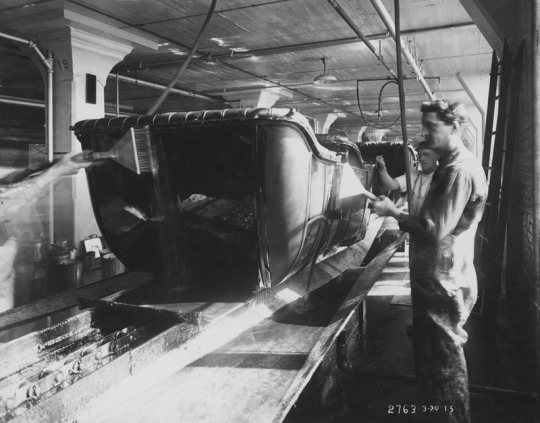
View On WordPress
0 notes
Photo
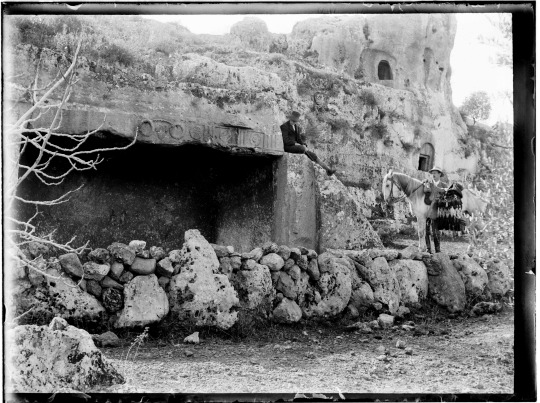






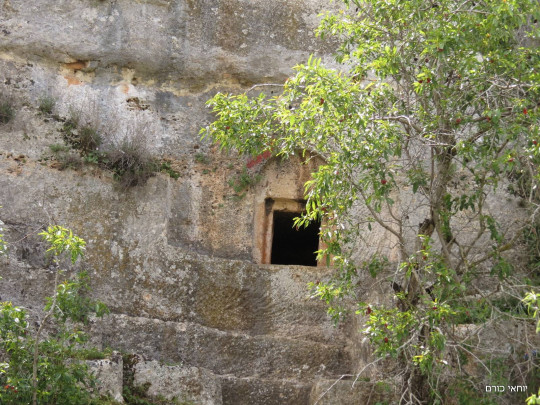
Makta Abuds East Tomb (Abud’s quarry, מַקַטַע-עַבּוּד)
Judea, Israel
1st century CE
The tombs in Makta Abud were incorporated into an ancient quarry that spans several hundred meters and was in ancient times a major stone source for the construction of the neighboring village houses, Abod. Hence the name of the site - 'Makta Abud' which means in Hebrew 'Abud’s quarry'. There are about 20 graves on the site, most notably two monumental tombs about 30 meters apart:
The eastern and samller of the two, had a decorated Doric facade distyle in-antis with both pillars missing today. Some of the burial chambers and Niches are decorated in Stucco in different colors and it is evident that this was a particularly rich population.
The cave has a wide and elongated hall, from which it continues to diverge in different directions. The cave contained large concentrations of pottery, glassware, stone vessels, metalware, coins, cooking pots and other objects and shire weights, all from the Early Roman period (2nd century CE). The cave was discovered by two British tourists, and was surveyed in a joint activity of the Cave Research and Land Studies and Archeology Department at Bar-Ilan University, in the fall of 2009, led by Boaz Zisso and Amos Frumkin. During the survey, many finds were discovered in the cave that were apparently brought to the cave by Jewish refugees, apparently residents of the nearby village of Aboud, during the Bar-Kokhba uprising. It is not inconceivable that it was the descendants of the wealthy families who carved the magnificent tombs in the Abod section, and this is evidenced by the varied glassware and various kinds of jewelery discovered among the other finds in the cave. Among the findings are crankshaft keys - silent evidence of the fugitives' optimism that they locked their homes as they escaped to the cave, pottery vessels which mainly include candles, storage jugs and cooking pots that teach how to organize, bring food and prepare for rebellion, stone tools that indicate that they were hidden in the cave Iron that teaches the fighting spirit that has been captured by the rebels. But the highlight is the coins: Twelve coins were discovered in the cave, six of them bear the same model - on one side the Tamar tree and the inscription 'Shimon' and on the other the Eshkol Geffen and the inscription "SH.B.L.KH.R Israel" (acronym for: שבלחר ישראל,Shana Beth LeKherout Israel, The second year of Israels freedom). Later in the cave, this area of Judea is probably destroyed by the end of the second year of the revolt, year 134.
These graves were used for the burial of Jews at the end of the Second Temple period. This area is part of the Land of Judea and was inhabited by a Jewish population from the end of the Second Temple period until the Bar-Kokhba revolt.
Picture sources: 1, 2, 3, 4, 5
#art#architecture#travel#history#jew#jewish#judaism#doric#tomb#grave#cave#rosette#Second Temple period#israel#judea#1 ce#in antis#distyle#distyle in antis#polychrome
112 notes
·
View notes
Link
Abstract: Indigenous people are often depicted as helpless victims of the forces of eighteenth and nineteenth century colonial empire building: forces that were beyond their understanding or control. Focusing on the story of a mid-nineteenth century diplomatic mission by Sakhalin Ainu (Enchiw), this essay (the first of a two-part series), challenges that view, suggesting instead that, despite the enormous power imbalances that they faced, indigenous groups sometimes intervened energetically and strategically in the historical process going on around them, had some impact on the outcome of these processes. In Part 1, we look at the story of one Sakhalin Ainu family over multiple generations in order to highlight the strategic place of the Sakhalin Ainu in cross-border relationships – particularly in the relationship between China and Japan – from the early eighteenth to the mid-nineteenth century.
The Mission
In late December 1853, about six months after US Commodore Matthew Perry arrived in Uraga Bay on his mission to ‘open’ Japan to the world, a Sakhalin Ainu (Enchiw) elder named Setokurero set out from the village of Nayoro on the west coast of Sakhalin island on his own crucial diplomatic mission.1 He travelled in a convoy of fifteen dog sleighs through the winter blizzards, accompanied by a retinue of some twenty Ainu elders from surrounding villages and one Nivkh man from the Amur region of mainland Asia.2 They were heading for Kushunkotan on the southern shores of Sakhalin, where the Japanese had established a fortified trading post in the early nineteenth century, and where the Russians had also recently landed to stake their rival claim to the island. The aim of the Ainu elders’ mission was to learn more about Russo-Japanese competition for control of Sakhalin, to express their own views on the matter, and to seek Russian help in resisting Japanese exploitation of the Ainu.
The Ainu of Sakhalin, Hokkaido and the Kurile Islands, like the Nivkh and Uilta indigenous peoples who also inhabited Sakhalin, lived in small self-governing villages and did not have any single dominant chief, but Setokurero was a particularly well known and influential elder. He was respected for his oratorical skills3, and his village and family had a special place in Sakhalin history (which we will explore further). His coastal community of Nayoro was – in terms of the modern concept of towns or even villages – tiny. In 1853, it consisted of six houses on either bank of a small marshy river, containing a population of around fifty people.4 But it was a crossroads and emporium on a far-reaching trade route whose tentacles stretched, at one end, deep into the heartland of the Chinese Empire, and at the other end to the Shogunal capital of Edo (soon to become Tokyo) and beyond.5 From the Chinese side, items like silk brocade, cotton cloth, metalware, decorative blue beads, tobacco and smoking pipes flowed into Nayoro and other points on the Sakhalin trade route, and some of these goods (particularly Chinese brocades) travelled on to the luxury goods markets of Japan. From the Japanese side came items such as rice, saké, miso paste, and pots and pans. The medium of exchange was ‘soft gold’ (as the Russians called it): fur, in the form of the pelts of sable, fox, sea otters and other animals hunted by the indigenous people of the region.
Read more...
https://apjjf.org/2020/22/Morris-Suzuki.html
#indigenous#ainu#nivkh#uilta#international relations#indigenous diplomacy#diplomacy#history#sakhalin ainu#east asia
11 notes
·
View notes
Video
youtube
Buddha dated 338, July 8, 2020
Later Zhao kingdom, Hebei, China
Bronze with gilding
H. 15 3/4 in x W. 9 1/2 in x D. 5 1/4 in, H. 40 cm x W. 24.1 cm x D. 13.3 cm
A Very Early Buddha
This sculpture is the earliest known, dated Buddha object produced in China, with an inscription on its base mentioning the year 338. This date, which is five hundred years after Buddhism was transmitted from India to China in roughly the second century bce, makes it an important milestone in the development of Buddhist art in China. This Buddha is among the largest bronze sculptures to have survived from this period.
The style of this Buddha was influenced by Buddhist sculptures from the ancient region of Gandhara, which included parts of modern Pakistan, Afghanistan, and northwestern India. The figure’s arrangement, with legs crossed beneath an evenly draping robe and set asymmetrically on a rectangular pedestal, is modeled after Indian sculptures brought to China via the Silk Road. However, this Buddha’s overlapping, inward-facing palms are adopted from a formal Chinese gesture of reverence.
The Late Zhao State
The fragmentary inscription on the back of the base attributes this sculpture to the Late Zhao, a small state founded by the Jie, a non–Han Chinese people from Central Asia who controlled China’s Central Plain during the fourth century. The state’s rulers regarded the Indian monk Fotudeng as their principal religious counsel and military adviser in the campaigns they undertook to extend their territory and authority.
Fotudeng had settled in the Central Plain in 310, preaching the Buddhist faith and seeking converts. He inspired Shi Hu, the third king of the Late Zhao, which may have prompted the ruler to commission this dignified statue. In 338, Shi Hu captured more than forty cities in the Central Plain. This Buddha was produced the same year, likely because the king believed it was a miraculous and venerated image, and worshiped it for blessings of victory.
Gilding Technique
Since gold was scarce and expensive in ancient China, it was often imitated with bronze thinly coated in gold, which also gave the metal greater resistance to tarnishing. This Buddha was cast to create a lustrous appearance using that particular strategy—gilded bronze. During the fourth century this highly costly technique was often used for small luxurious icons. The entire gilding over this large Buddha, much of which has been preserved, made the sculpture one of the most accomplished of that time.
The Chinese use of gold on bronze goes back more than two thousand years and was applied using a technique known as “mercury gilding.” The bronze is coated with a thick, melted liquid made primarily of mercury and gold, then heated by charcoal fire. The gilding is achieved by burnishing the liquid atop the surface so that it adheres without allowing air to permeate. Double-gilded pieces are more expensive than partial-gilt or plain metalware.
Resources:
Asian Art Museum: 338 Buddha with Michael Knight: Part 1, Part 2
Michael Knight discusses the oldest known dated Buddhist sculpture, which is in the Asian Art Museum's collection. A lecture presented by the Society for Asian Art on April 24, 2015.
Collection of the Asian Art Museum
#Asian Art Museum#Buddhism#shakyamuni#figure#bronze#gold#gilding#Later Zhao dynasty#Jie#Xiongnu#4th century#Hebei#sixteen kingdoms#Jin dynasty#Chinese#art#art history#archaeology#metal#sculpture#technology#cultural amalgam#repurpose#indo iranian
3 notes
·
View notes
Text
Ramblings on new lore location:
Four Lips Kiss is the unofficial name for a place in Shadow where four mountains grew up unusually close to each other. A few dragons make their homes on the slopes and peaks, but most live in the numerous valleys, hollows, and coves.
There is no town or central seat of government. The closest thing to one is a little cluster of buildings consisting of a general store, forge, tavern and inn located in one of the passes out of the mountain. Traders and travelers pass through here on their way to more interesting places. Locals come when they need to or want some company.
Culturally, art and craft are very important. Everybody does their best to cultivate some kind of "making” skill, be it woodcarving or embroidery or even coming up with little songs. Anything meant to last is decorated, though not all art is meant to be shared. It’s not uncommon to be walking through the woods and come upon some little sculpture by a riverbank or colored stones hanging from a tree. Disturbing another’s art isn’t done, though adding to a display is acceptable and even encouraged.
Despite being in the Shadowbinder’s domain, there are two minor deities who call these mountains home. Lady is the aspect of freezing spring, the time of year when buds try to grow but are snapped off by the frost that still comes. She walks around openly and lives with dragons who politely pretend not to recognize her. Dragons acknowledge her by throwing a pebble (or if necessary, a piece of twig) across running water before they cross, especially when there’s snow on the ground. The other is Mistmaker, who creates the early morning fog. She’s more aloof. Though fog is considered good luck, catching a glimpse of its source is a sign of great misfortune. Dragons win her fortune through music and song.
Most dragons in the region farm for their living. Some keep goats for their wool, though many wear clothing made from imported fabric. Glass and plastic goods make their way into the region via various traveling merchants who take metalware, woodcarvings, and preserved fruit to sell in other markets.
6 notes
·
View notes
Text
All About Rural Craft
The Rural crafts of India are varied, rich in culture, history and faith. The craft of every nation in India reflect the effect of various empires. Through centuries, crafts are embedded as a tradition and culture in rural communities.
Metal crafts comprises metal work utilizing Zinc, Copper, Brass, Silver, Gold. A number of the Standard early handicraft fashions are Bidriware, Pembarathi Metal Craft, Dhokra, Kamrupi

Bidriware The expression'Bidriware' originates in the township of Bidar, which remains the primary center for the production of this special metalware. Owing to the striking inlay art, Bidriware is a significant export handicraft of both India and is prized as a sign of wealth. Pembarathi Metal Craft They are popular because of their beautiful sheet metal art functions. This meticulous metal perform art flourished during the reign of Kakatiyas Empire. Kakatiyas widely used sheet metal artwork to decorate chariots and temples. Dhokra is non-ferrous metal casting with the lost-wax casting procedure. This kind of metal casting was used in India for over 4,000 decades and is still utilized. Among the earliest famous wax wax artefacts is that the dance girl of Mohenjo-daro. The merchandise of dhokra artisans are in fantastic demand in foreign and domestic markets due to crude simplicity, enchanting folk themes and solid form. Dhokra horses, elephants, peacocks, owls, spiritual pictures, measuring utensils, and blossom caskets etc., are tremendously valued. Kamrupi Brass and Bell Metal goods of Kamrup are famed for their beauty and durability of form and usefulness. Brass is a significant cottage industry, with maximum concentration in Hajo, while Sarthebari is well-known for its bell metallic craft. Gold, silver and aluminium also have shaped part of classic metalcraft in Kamrup, along with the State Museum at Guwahati includes a rich selection of things made of those metals.
1 note
·
View note
Text
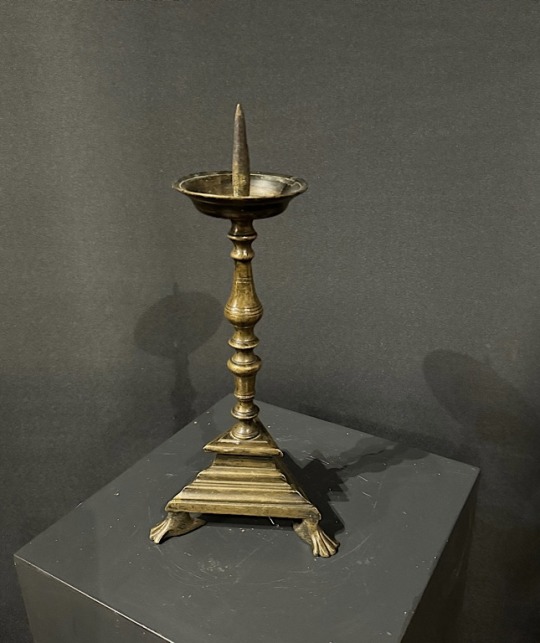
THIS FINE PRICKET STICK HAS A TRIANGULAR STEPPED BASE WITH LION PAW FEET, THE TURNED COLUMN WITH DRIP PAN AND PRICKET.
Visit us at: https://www.periodoakantiques.co.uk/antique-new-stock/a-fine-early-17th-century-brass-pricket-stick-circa-1620-17-stockno-1725/
0 notes
Text
title: s’ agapó.
anonymous requested: “May I make a request? John/Paul, doesnt matter which one, proposes to the other sometime around '66? Obviously they couldn't do it legally moreso one of them asking the other to be their spouse on a personal level. I'm shit at explaining my thoughts sorry haha.”
warnings: alcohol, babeey.
author’s note: aw, anon, deary, you explained it well!
---
1966,
Paul felt hot and sweaty in the steaming Greek sun as he laid on the edge of a stark white beach chair, absorbing all the sun’s rays that shined down upon him. It was his first vacation in a long, long, while and it was peaceful. And he was here with his boyfriend, John, who were still sleeping inside their rented villa. It was a big day. Paul, who had finally gotten over his worries and qualms about his sexuality and all that came with it, had planned the day out to lead to one big thing; the proposal of marriage to John.
Now, marriage between two men wasn’t legal. Basic romantic relationships between two men had barely just gotten legal earlier that year. And Paul still had no plans to get out and open about it as much as he had come to self-acceptance. The proposal would be purely… ceremonial. Romantic and a promise to each other; to be with each other and true to each other. One night stands and frisky affairs were something Paul was more than willing to sacrifice for the thoughts of spending the rest of his life with John.
--
John woke up to a light afternoon breeze shifting through the linen curtains of the open balcony doors. The door to the bedroom stood wide open and through it came a wave of the delicious smell of grilled chicken, spiced just right with purchases from the local market. He rolled over in the bed with a sigh as he slowly allowed himself to wake up as he stared at the bare ceiling.
It was in the middle of the first week of his trip to the Greek isle he had completely forgotten the name of. Something Greek, surely, but overall he didn’t quite care to know its name. All he cared about was spending time with his boyfriend, Paul, of… many years. Who, by the way, John noticed was missing by the side. The sheets were neatly done with his lover missing. He patted the missing spot before groaning as he forced himself to sit up straight and swing his legs over the edge. He sighed in relief when the warm soles of his feet hit the comfortably cool floor.
As it smelled of cooking all through the house; John quickly deduced that Paul could only be in the kitchen. They were all by themselves in the house; no ‘servants’ as their relationship still were quite secret. John wanted nothing more to flaunt his love and show it to the world! But he had to respect Paul’s hesitance about it. John was very well aware of the damn bigotry of the world but, fuck, he just wanted people to know Paul was his and he was Paul’s.
He heard shuffling in the kitchen, the sound of metalware moving around and the hissing of water hitting the sink, and slowly made his way down the stairs; quietly so as to take his partner by surprise. Paul stood with his back turned to the open doorway; dressed smartly in a light blue, almost white, henley tee and white shorts making John feel underdressed in his briefs and a hastily thrown on bathrobe. John sprang lightly on his feet and grabbed Paul by the waist with the yell of ‘boo’ as his fingers touched Paul’s lithe figure. Paul loudly yelped and turned around in John’s hands with his hand on his heart, the other holding a knife.
“John! Don’t do that! I could’ve stabbed you!”
He breathed heavily, putting the knife aside as he calmed himself down. John, of course, was grinning at the reaction he had gotten and kissed Paul lightly on the cheek; immediately after he stepped aside to look at what the knife had been used for and saw rows of various vegetables lining the table. He quickly snatched a slice of tomato which earned him a playful slap on the wrist by his boyfriend who now too had turned around to resume his slicing and dicing. Time quickly passed by with Paul preparing and cooking the food while John ran around doing anything but helping in the kitchen. He was absolutely shite at anything that could go in there and resigned himself to get dressed and distracting Paul with various dirty jokes and puns and whatever he could think of.
The wind was still as they ate on a patterned picnic blanket on the terrace; in the hot evening sun with candles lit all around them. It was romantic, despite the obvious fire hazard it made.
Paul was fighting up the urge to stand the speech he had long gone through his head. He wanted it to be romantic, teetering on the edge of the dramatic but not so much that it would scare off John. He had gone over it with the same fever he gave his musical work and he had hoped and prayed that it would all pan out like he so desperately wanted. He swallowed deeply as he got loose from John’s intertwined hands in his to get the last part of his grand plan. Two wonderful glasses of champagne that he got from inside. His legs felt weak as he went through the house to the kitchen and he took heavy breaths as he worked his way back to his boyfriend and, hopefully, future fiancé.
But his steps faltered as he came to the terrace steps and almost dropped the glasses he was holding (now for dear life) as he blinked in shock at John on his knees, looking up at Paul with watering eyes. In between his thumb and index finger; he was holding, very carefully, a small ring. It was nothing out of the ordinary but Paul’s heart soared at the sight of it. Both were silent.
John was unsure of what to say or do next; it had all been very impromptu. Sure; he had gotten the ring days prior after waking up early and feeling a sense of love and family he had never felt before as he looked down at Paul’s sleeping form. But he hadn’t planned for it to go quite like this. In fact, he had never planned for it at all. But the ring had been in his pocket ever since he bought it and there was something magical about this evening and of how the warm light hit Paul wonderfully; casting loud reminders to John of when he first fell in love with Paul and of the ring burning in his back pocket. But Paul was silent still and dangerously so in John’s mind.
But it was not unacceptance that kept Paul quiet. It was the exact opposite and, well, shock. Soon he would see the humour in the situation but it wasn’t quite time for that yet. For now, he looked down at his lover who had had the same idea as him all along. He went to his knees and carefully placed the glasses on the brick flooring before softly placing his hands on both sides of John’s head to pull him into an equally soft kiss.
They parted and John, with a smile to rival the Greek sun earlier that day, laughed in an equal mix of relief and hope, “is that a yes?” And it was answered by the most enthusiastic of nodding he had ever seen as Paul pulled him into another kiss.
15 notes
·
View notes
Text
Vintage Recipe Boxes and Cards
November ushers in a happy season of holiday cooking, inspiring me to focus this month’s featured post on vintage recipe file boxes and cards.
File boxes and index cards are not obsolete, but before the computer age, they played a much larger role in collecting and storing information. Index cards were invented in the 1640s by Carl Linnaeus, the father of modern taxonomy. Originally pieces of regular paper but later made from more durable card stock, index cards proved very useful to many, and became the backbone of the library cataloging system that began in the 19th century. In 1870 Melville Dewey standardized library indexing, and the Dewey Decimal System was used until the 1980s, when information compiled by hand began to give way to indexing software.
Histories of the index card center on its use in gathering and organizing scientific information and library catalogs, with very little, if anything, said about recipe collection and organization, so I’ll simply share what I know.
In the 20th century many homemakers used index cards to store and share favorite recipes. Standard index cards were joined by cards specifically printed for recipes, often bearing the words “From the kitchen of ______, ” with space for the cook to write in her name. Companies in the food industry and agricultural associations often distributed cards with printed recipes utilizing their ingredients, and some homemaking magazines had cut-out sections with recipes cards. These cards were generally saved in file boxes.
Vintage recipe file boxes were usually made from wood or metal, although I’ve occasionally seen plastic examples. The standard index card size was 3x5 inches, but some were 4x6 or 5x7. Larger cards, including ones that folded down to the standard 3x5 size, were popular for longer or more complex recipes.
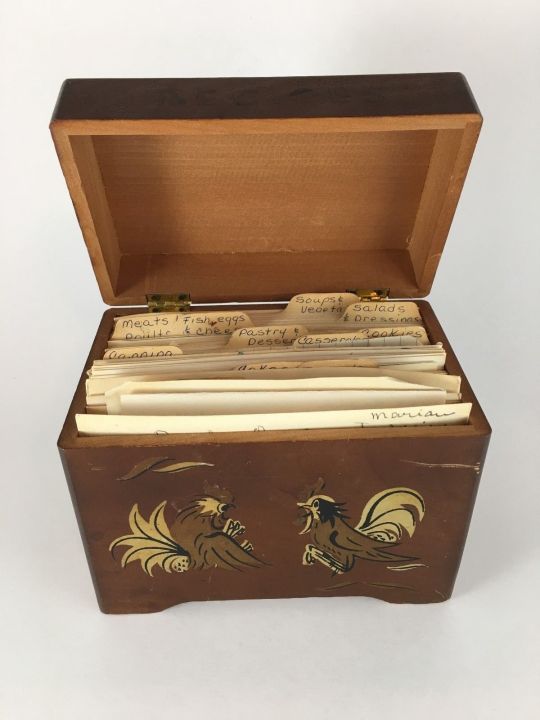
Vintage wooden recipe box with rooster design, from an estate sale. Hand-written category tabs organize this recipe collection. This is a very typical file card recipe collection.
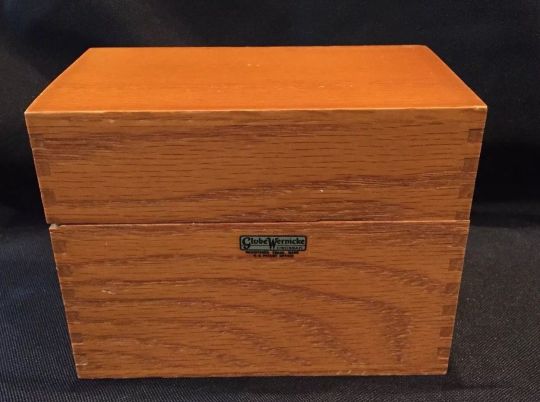
Vintage dovetail oak index file box by GLOBE-WERNICKE.
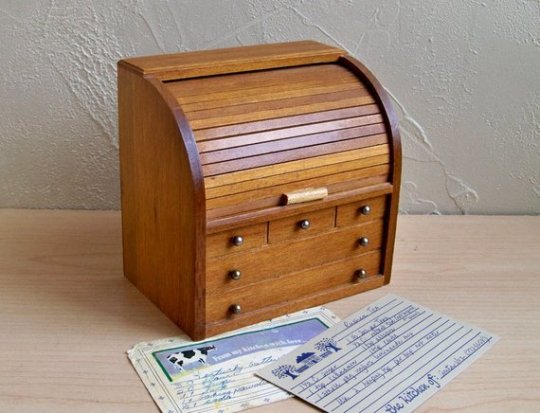
Vintage recipe file box made to look like a miniature rolltop desk. This was a popular style.
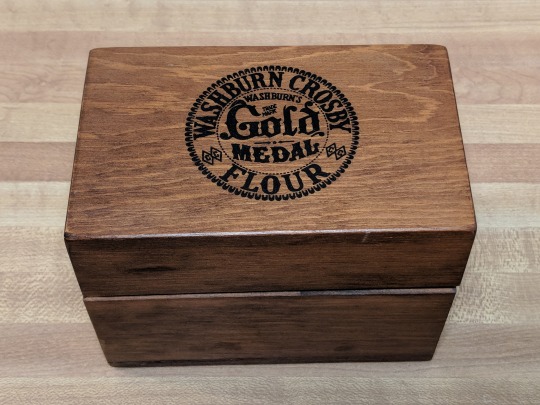
I’ve had this wooden recipe file for decades. It was a promotional item from Gold Medal Flour.
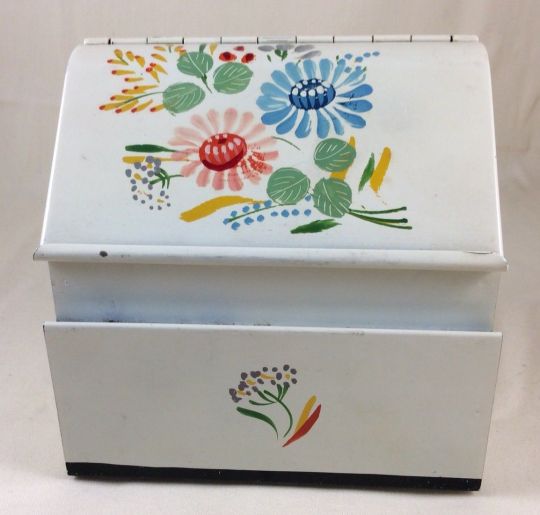
Vintage Ransburg hand-painted recipe file box.
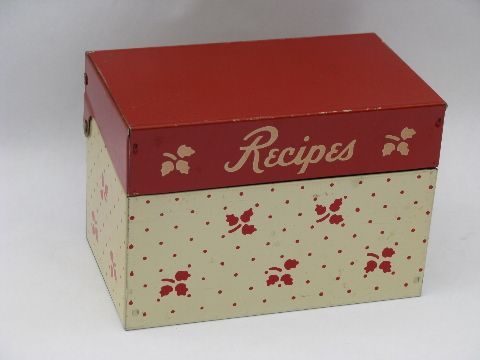
Vintage red and ivory metal litho “Recipes” file box.
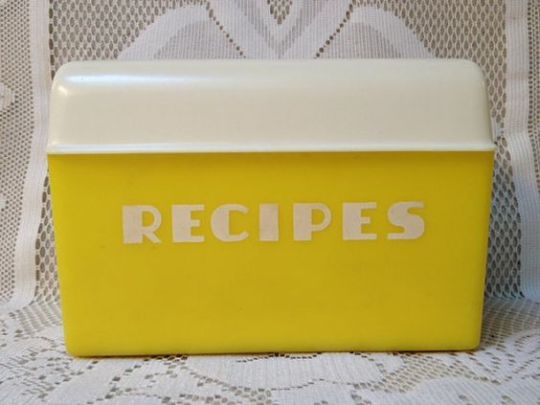
Vintage yellow and white plastic “Recipes” box.
Ransburg produced hand-painted metal recipe boxes. Most other metal recipe files were decorated with lithography, many by the Ohio Art Company. Founded in 1908 and based in Bryan, Ohio, Ohio Art is still in business, famous for its metal lithography and manufacturing, and also for its toys. Ohio Art made wonderful metal toy dishes and toy pail and shovel sets that delighted generations of children. They later turned to other types of toys, including the Etch A Sketch.
Another name that comes up often when finding vintage metal litho recipe file boxes is J Chein & Company. Founded in New York, J Chein primarily manufactured toys from 1903 through the 1980s. J Chein’s stamped tin litho toys from the 1930s through the 1950s, depicting the circus and amusement park attractions, are especially well-known.
I have also seen examples of metal litho recipes boxes by Syndicate Manufacturing of Phoenixville, Pennsylvania, and by Stylecraft.
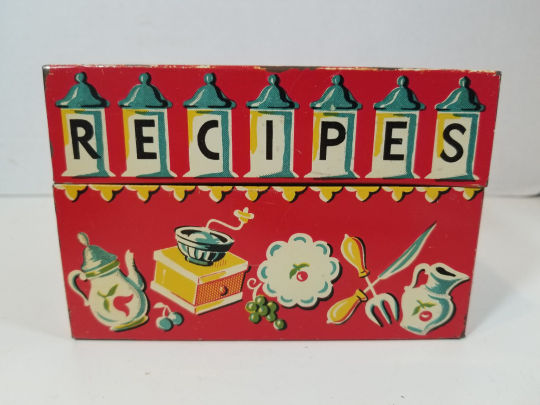
Isn’t this wonderful? Vintage Stylecraft metal litho red file box. “RECIPES” is spelled out with spice jars.
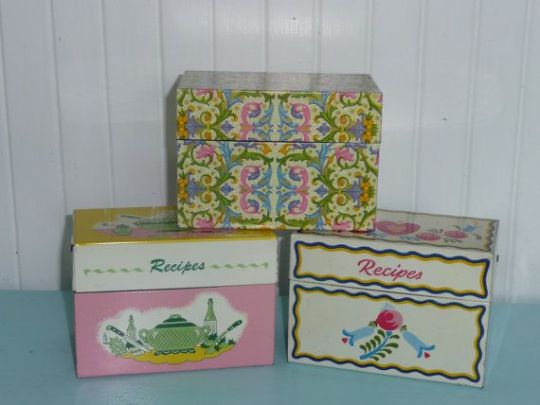
A collection of Mid-Century metal litho file boxes, including one with a pretty Florentine scroll design, and two marked “Recipes.”

Mid-Century Ohio Art metal litho “Recipes” file box, decorated with fruit and kitchen items. In addition to the usual coffee and tea pots and coffee grinders, there are even chafing dishes.
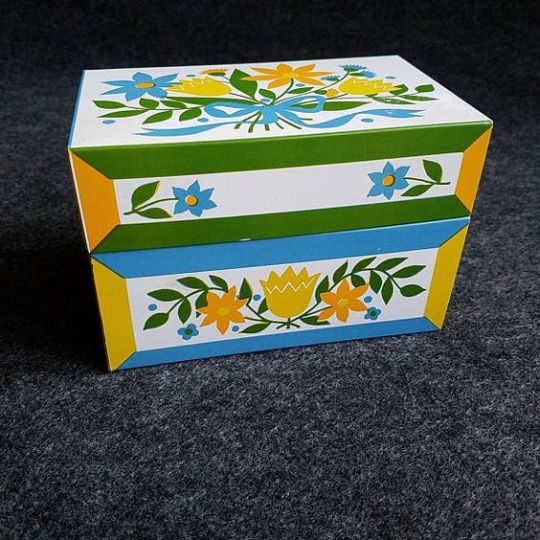
Vintage Syndicate Manufacturing metal recipe box with a Pennsylvania Dutch folk art-inspired design. This model was often seen in the 1960s and 1970s.
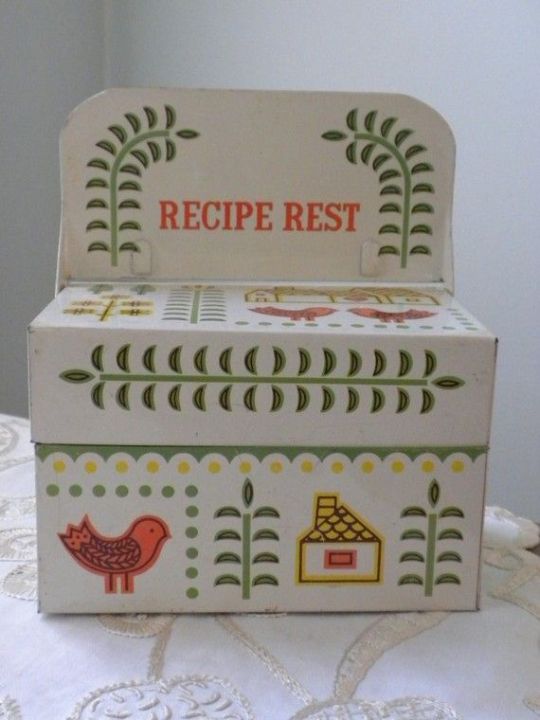
This vintage metal file box includes a “Recipe Rest” for propping a file card while cooking.
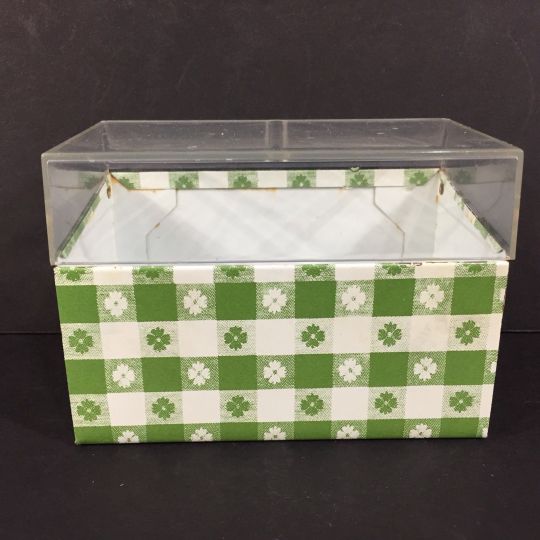
Vintage J Chein Co recipe file with a green and white tablecloth plaid metal litho bottom and a clear lucite top. In business from 1903 through the 1980s, J Chein & Company was an American toy company, best known for its tin litho toys produced from the 1930s through the 1950s. Some examples of J Chein recipe boxes are marked “J Chen,” which makes me suspect they were made overseas.
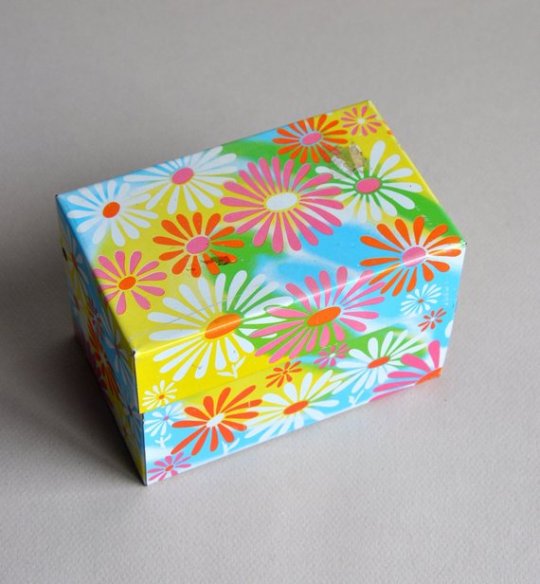
Vintage “flower power” design metal recipe file, marked Syndicate Mfg Co, Phoenixville Penn. The illustration dates this one to the late 1960s or early 1970s.
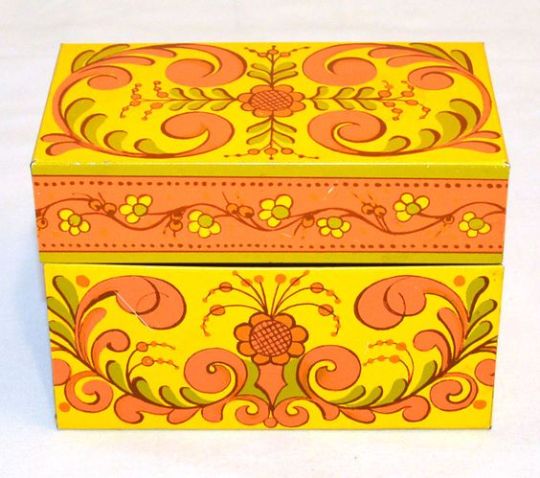
Vintage metal recipe file box, sold by Avon.
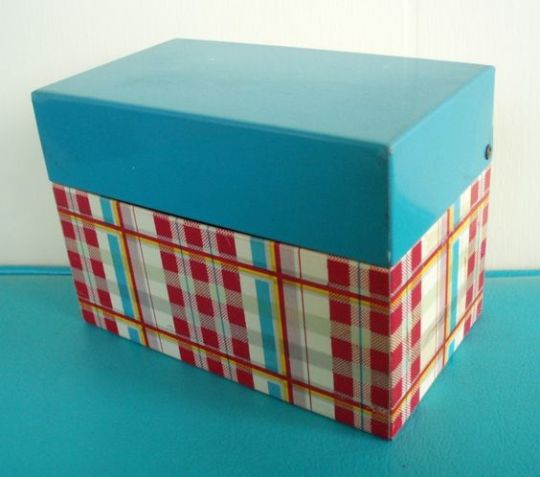
Vintage Ohio Art metal litho recipe box with a plaid base and a solid blue top.
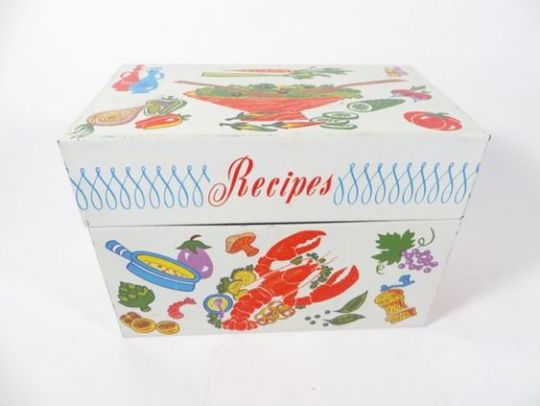
Vintage metal Ohio Art recipe file, from my personal collection. The Ohio Art Company is famous for its metal litho products, especially kitchen ware and toys.
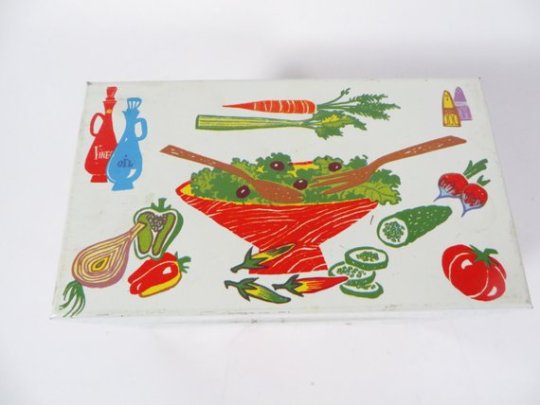
Illustration on the top of my vintage Ohio Art recipe box, showing a salad and its ingredients.

Interior of the vintage Ohio Art recipe file box.
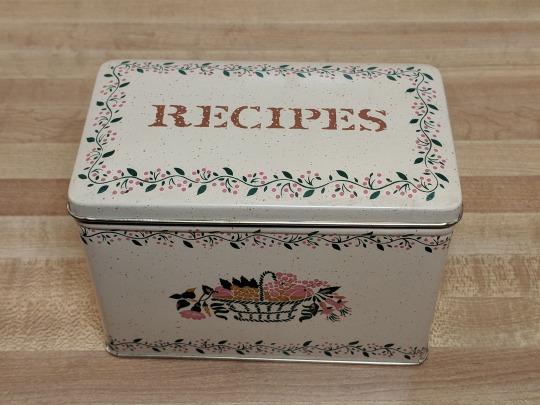
My other recipe file is this “Americana Stencil Metalware Recipe Box” bought at the local Kmart in the 1980s. The box it came in is marked copyright 1984 The Tin Box Company of America.
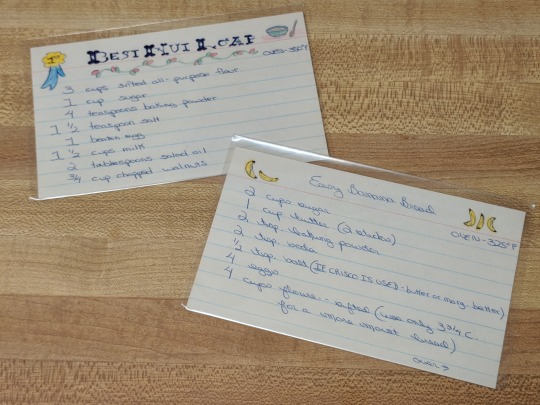
I started my recipe collection when I was growing up, and hand-decorated plain index cards with little drawings.
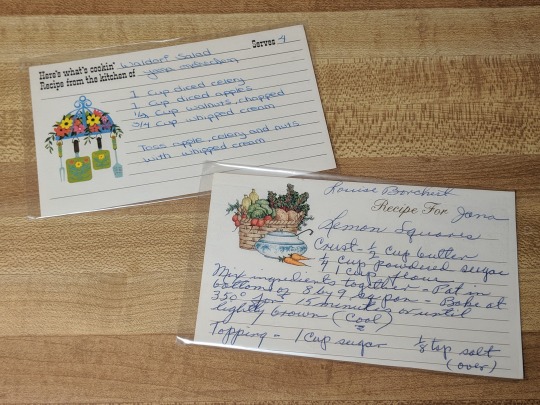
As a young adult I began using printed recipe cards, and also exchanged recipes with friends. Plastic sleeves protect the cards.
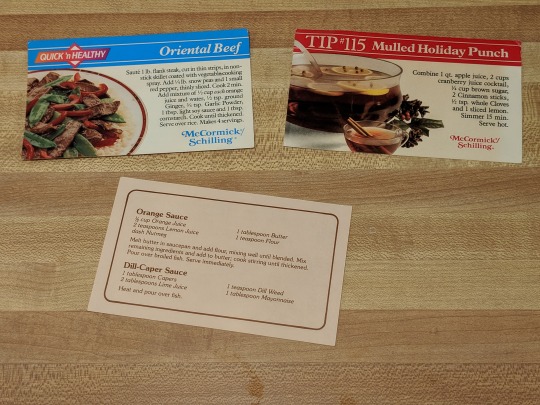
Printed recipes from the food industry, given out at grocery stores and county fairs.
Today many cooks keep recipes electronically, yet wood or metal recipe boxes, and the cards and dividers for them, are still sold. I enjoy finding recipes online, but still find it useful and satisfying to keep my favorites on index cards. This low-tech tradition takes up very little space, makes it easy to reference a recipe while cooking, and offers a method of preserving recipes that is not dependent on software or hardware.
It’s easy to start or add to your own collection. You can find many types of new or vintage cards and boxes. I find protective plastic sleeves helpful for keeping my cards clean.
Promotional or branded recipes boxes from companies such as General Mills and Campbell’s Soup have been offered to generations of cooks. I’ve shared a photo of a wooden General Mills box I’ve been using since the 1980s or early 1990s, and they’ve also had metal recipe boxes. Campbell’s Soup has a metal litho file box “starter set” of cards with Campbell’s Soup recipes plus 24 blank cards, and Coca-Cola has a set of 75 recipe cards with color photos sold in a metal litho box. (I have an older version.) There is also a Jell-O Recipe Collection with a metal box containing 76 cards with Jell-O, Cool Whip, Baker’s, and Jet-Puffed recipes. At the time of this posting all of these sets are available on Amazon, and I’m sure you can find even more.
I wish you the fun and joy of holiday cooking, and hope you’ll have a chance to share or swap a recipe or two along the way!
#vintage kitchen#recipe box#recipe collections#recipe files#index cards#Carl Linnaeus#taxonomy#melville dewey#dewey decimal#globe-wernicke#gold medal flour#ransburg#ohio art#ohio art company#j chein & company#metal litho#tin litho#stamped litho#Syndicate Manufacturing#stylecraft#midcentury#avon#the tin box company of america#campbell's soup#CocaCola#jell-o
2 notes
·
View notes
Text
Modern Accoutrements For the Modern Home

Houseware is important to operate a kitchen, and just as important are smaller items which are not thought of as large appliances such as stoves and refrigerators. Flatware, pots and pans, cups and plates, and other flatware are all necessary essentials for serving and cooking food. However, there is no way to see the food without having touched it, right? That's where the dishwashers come in. These appliances work by taking the food out of the kitchen and putting it into a cleaner vessel before transferring it back to the kitchen.
Many different types of household appliances exist, from the small and simple to the large and complex. Some housewares make these simple and small items much more manageable and easier to use, while others make them appear as if they were designed specifically to be pieces of art. Dishwashers have evolved over the years from simple attachments to large multi-functional systems, each with their own special purpose. For example, a dishwasher today may have separate settings for sanitizing, drying, rinsing, cooking, drying, setting temperature, and cleaning among other options. One type may even have the capability of being connected directly to the faucet, meaning the faucet will become an extension of the dishwasher.
Dishwashers are the first steps in modern household appliances. This appliance is the backbone to most of the other household appliances found today. Without dishwashers, most kitchen environments would be very messy, filthy, smelly and unhygienic. The invention of dishwashers paved the way for the creation of a plethora of other household appliances. Some examples are the built in ovens, microwaves, dishwashers, toasters, refrigerators, washers, dryers, food processors, washing machines, cutters and dishwashers.
The invention of the microwave is probably the greatest single development in the history of the houseware industry. It made cooking so much easier. With the invention of microwaves came the creation of the high end F.B.M. industry (Food and Beverage Manufacturer and Retailer), which literally changed the way people cooked by bringing a tremendous level of control and quality to the kitchen. Click here https://bepduybao.com
Ironware, on the other hand, was originally created for the use of outdoor conditions or the battlefield. Early ironware was made of a metal that lacked flexibility and therefore cracked easily. This made ironware for outdoor conditions an unattractive item, but it also meant that household furnishings could be found in colors other than white. As the industrial revolution progressed, more metalware was developed for indoor uses such as the baking pan, casserole dishes, French press, ice cream maker, pasta sauce, pie crust, platters, shakers, bowls, and pitchers.
In modern times the houseware industry has focused its efforts on creating appliances that are beautiful, practical, durable, affordable, and easy to clean. Although there are still many iron items on the market, most kitchen furniture is now made from either stainless steel or aluminum. Both materials are extremely durable and they are also very easy to maintain. People often choose stainless steel appliances, because they do not yellow as easily as the aluminum ones. Stainless steel also resists stains and scratches, which mean that metalware accoutrements can be kept looking like new.
Due to the focus on practicality and durability that modern housewares have come to represent, small kitchens seem to be the height of sophistication. Many young people love modern housewares such as the popular stainless steel pots and pans. These housewares allow them to create authentic culinary experiences while saving money on food costs at the same time.
As the cost of metalware and other housewares goes down, people may find it more convenient to purchase more affordable accessories. Small appliances, for instance, are very affordable nowadays. In addition, there are a lot of online stores where consumers can find a wide variety of contemporary housewares and other household furnishings at a fraction of the cost. Anyone can find high quality yet affordable metallic accoutrements today.
0 notes
Photo

Pitcher, Clara Barck Welles, 1916, Minneapolis Institute of Art: Decorative Arts, Textiles and Sculpture
panel form pitcher Clara Barck, an early advocate of modernist design, established the Kalo workshop in 1900, shortly after graduating from the School of the Art Institute of Chicago. The shop first focused on handcrafted leatherwork and weaving, but increasingly concentrated on metalwork after Barck married George Welles, an amateur metalworker. Barck Welles oversaw the production of a wide range of handcrafted copper, brass, and silver household wares, and helped to establish the Kalo Shop as the leading producer of metalware in Chicago. The angular form and sleek, modern silhouette of this pitcher is offset by the irregular surface texture. The preservation of the hammered finish reinforces the handcrafted nature of the object. Barck Welles' pitcher represents the voice of the Arts and Crafts movement in an era of industrial production - one that rejected the impersonal nature of factory produced wares in favor of handmade objects created by talented artisans. Size: 8 x 10 1/4 in. (20.3 x 26 cm) Medium: Sterling silver
https://collections.artsmia.org/art/8423/
0 notes